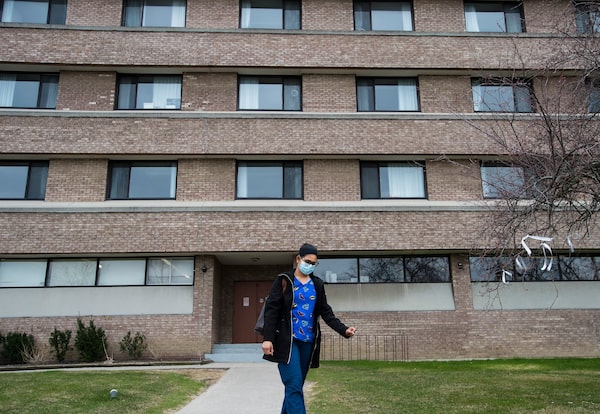
A healthcare worker leaves after finishing her shift for the day at the Eatonville Care Centre in Toronto on Friday, April 24, 2020. Ontario's long-term care commission is hearing from healthcare workers that they "still have an acute staffing shortage."Nathan Denette/The Canadian Press
The Ontario government says it is reviewing urgent recommendations from its independent commission on long-term care homes, which issued a report on Friday that calls for beefed-up staffing and faster virus testing and concludes residents were left “forgotten” until COVID-19 deaths started to mount.
As infections continue to rise in more areas across the province, Ontario Premier Doug Ford also said Friday his government could announce whether Halton and Durham Regions – or other areas – will join Toronto, Ottawa, Peel and York Region with new restrictions, such as an indoor dining ban, as early as Monday.
The government ordered a partial lockdown two weeks ago in some COVID-19 hot spots, but new daily infections have not yet come down and outbreaks are again multiplying in long-term care homes. They were hit hard in the first wave and prompted an independent review of the sector and government’s handling of the elder care crisis.
Hospitals and long-term care homes in Ontario have little room for second-wave surge, inquiry hears
In a five-page letter released on Friday, the three-member long-term care commission led by Associate Chief Justice Frank Marrocco said it was making a series of early recommendations because of the urgency of the situation in long-term care, where outbreaks are climbing. Its final report is not due until April.
“We have heard that long-term care (LTC) homes were forgotten in the initial provincial plans to control the spread of COVID-19 until residents started dying, and pleas that this not be repeated when this crisis is over,” the commission’s letter reads.
More than 1,980 residents and eight staff have died in the province’s long-term care homes from COVID-19, and the number of long-term care homes with outbreaks in Ontario has quadrupled over the past month.
The government’s Minister of Long-Term Care, Merrilee Fullerton, said in a statement that her department was “carefully reviewing” the recommendations and was spending $500-million to protect long-term care in the virus’s second wave.
Ontario also said Friday that the federal government was providing Canadian Red Cross teams for “short-term support” in the Prescott and Russell Residence, a long-term care home in Hawkesbury, Ont., in Eastern Ontario. The province said the home is suffering “significant challenges due to COVID-19.”
Mr. Ford also defended his government’s actions, while also calling for more health care funding from Ottawa.
“It’s No.1 priority, to take care of the most vulnerable people in society,” the Premier said of long-term care. “We inherited a broken system.”
The commission says the sector has “critical staffing shortages” that predate COVID-19 because of “long-standing recruitment and retention challenges.” While recognizing the government’s temporary $3-an-hour pay boost for personal support workers, it says more needs to be done.
It calls for more personal support workers, full-time staff and nurses, and for homes to proactively set up relationships with hospitals that can help in an outbreak.
The report also recommends developing a comprehensive plan for the investments needed to deal with staff shortages. And it recommends a guarantee of four hours of direct care for each resident, a move long demanded by unions and health care groups that could cost $1.8-billion. These and other measures, the report notes, were already recommended in a government staffing study released this summer.
“Further ‘study’ of the Study is not necessary,” the commission’s letter reads. “What is required is the Study’s timely implementation.”
Doris Grinspun, chief executive of the Registered Nurses' Association of Ontario, said the commission is clearly issuing a call for permanent solutions to the staffing crisis.
“This is not Band-Aid approaches anymore,” she said. “We are already three months late.”
The commission also calls for better infection and prevention control measures and enhanced government inspections. The Globe and Mail reported last month that infectious-disease experts had warned the government in June about the sweeping changes needed in long-term care, but that Ontario had not started implementing their recommendations.
The commission’s letter also calls for priority testing and faster turnaround results for residents and staff. Delays in testing have prevented nursing homes from controlling the spread of infection.
Senior health officials briefed reporters on Friday about the impending arrival of new rapid tests obtained through the federal government. They said an initial batch of 100,000 rapid tests is to be rolled out to remote communities and places with outbreaks sometime in November.
Matt Anderson, president and CEO of Ontario Health, said testing delays have been partly owing to problems related to transporting samples. In some cases, a lab runs out of capacity and a sample sent there must be couriered to a second lab, wasting valuable time. He said an improved, centralized system will send samples directly to labs with spare capacity.
Our Morning Update and Evening Update newsletters are written by Globe editors, giving you a concise summary of the day’s most important headlines. Sign up today.
 Jeff Gray
Jeff Gray Laura Stone
Laura Stone